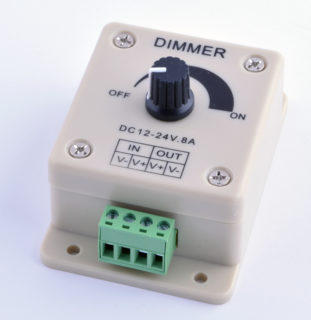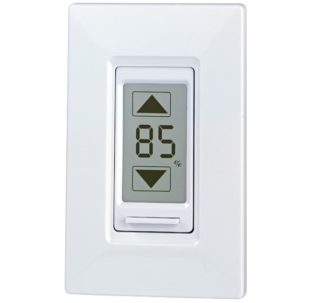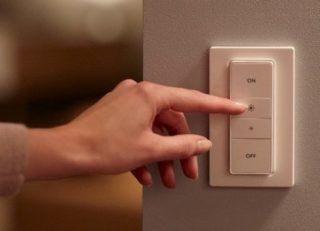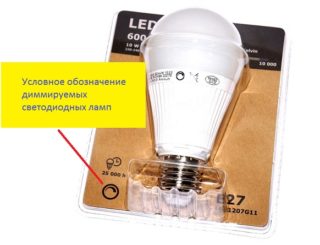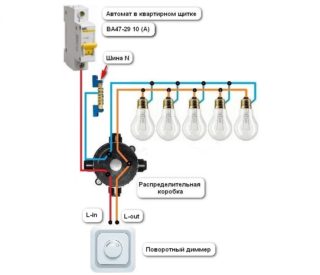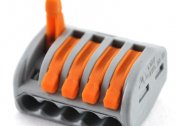LED light sources are modern, economical and efficient. To control the brightness and level of illumination in the lamp there is a special device - a dimmer. Adjusting the backlight allows you to save energy and create a different atmosphere in the room.
Principle of Operation and Design
A dimmer is an element that allows you to smoothly change the intensity of artificial lighting, turn on and off the bulbs, remotely control the light. Adjustment is carried out by changing the voltage and, accordingly, the power of the device. This can be done by adding load - ballast resistors, capacitors, chokes. In LED lamps, the adjustment is made using dimmers.
Not every LED light source can be dimmed. For stable lighting control, special controllers or devices with a PWM function are needed. It is important to choose the right regulator for the bulb, since the quality of the lighting change will depend on its circuitry.
The dimmer works like a rheostat. The voltage or current changes as a result of a change in resistance. Nowadays, semiconductor regulators are actively used - triacs and dinistors operating on the basis of the PWM principle.
The advantages of dimmers include:
- creating comfortable lighting at any time of the day;
- energy saving;
- reliability;
- smooth inclusion;
- it is possible to control several lamps;
- increase the life of lighting devices;
- ease of installation;
- the ability to synchronize with the smart home system;
- creating unique visual effects.
Saving electricity is the most important advantage of dimmable devices over conventional light sources. By adjusting the light level, the lamp will not burn all the time at full power and, accordingly, consume a large amount of electricity. Such use leads to an increase in the life of the lamp.
Disadvantages:
- high price;
- improper selection of the controller can lead to malfunctions;
- cheap appliances can cause interference;
- sensitivity to elevated temperatures;
- low efficiency in night mode.
Regulators for 220 V and 12 V have structural differences. The simplest mechanisms that masters can do at home perform the function of changing the light intensity. Modern models have a wider functionality - for example, the "Sleep" function, in which the brightness is maintained at 30% of full. There is also a “good morning” function when the intensity increases, or “good night” when the light becomes more dim.
Light regulators are applied in different areas. In home lighting, in billboards, for entertainment purposes. Adjustable lamps are used in office fixtures of VG SKUL 1200-36 W.
Dimmers are an important component of the smart home system. An important function of regulators is the emergency lighting system. When operating on battery or battery, the service life is increased by reducing the brightness.
Varieties of Dimmers
Regulators are classified according to various criteria: type of voltage in the circuit, type of control signal, installation method, design.
According to the voltage in the network, the light regulators can be divided into two groups:
- for alternating voltage 220 V;
- for constant voltage on the LED strip 12 V.
The type of control signal distinguishes dimmers for LEDs:
- analogue
- digital
- digital to analog.
According to the installation method, several types are distinguished:
- modular, which are mounted in a special DIN rail in the distribution panel;
- remote mounted in a chandelier;
- wall mounted, which are installed instead of the switch.
By control method:
- rotary - adjustment is carried out using the handle;
- keyboard - buttons are controlled;
- rotary-push - regulation is performed by pressing the buttons and turning the handle;
- sensory - models with various sensors;
- remote - are controlled by the remote control via Wi-Fi, a radio channel or infrared port.
The most expensive are touch light controls. These are modern devices that can be controlled by voice commands, movements, claps.
Criterias of choice
LED light sources can be adjustable and unregulated. This must be considered when buying. Regulators should be selected taking into account the following aspects:
- The ability to adjust the light source. Do not place a dimmer on an unregulated LED lamp. This will result in damage that is not covered by the warranty.
- The number of light sources that the dimmer will control. For one bulb, it is enough to purchase a low voltage regulator.
- Bulb power and minimum dimmer load. For most regulators, the minimum load is 20-45 watts. This power can be achieved with the help of 2-3 LED lamps connected to a 220 V network.
- The total load on the device. The dimmer power must be approximately 30% higher than the total connected load.
- Voltage. For lamps, you need a dimmer that works with a 220 V network, and for tapes - for 12 V or any PWM controller.
When choosing a regulator, you need to give preference to proven well-known brands. These include Schneider Electric, Legrand, Makel, ABB and others. Poor-quality goods of unknown origin may cause lamp failure. Also, you need to take devices in specialized stores. There, the seller will help with the choice of a dimmer, give tips on connecting and talk about the conditions of the guarantee.
Calculation of the maximum number of lamps
The total number of bulbs is selected based on the maximum power of the dimmer. The calculation is made taking into account the type of room, the type of lamp.
To calculate, you need to divide the limit value of the regulator by the power of one bulb. The resulting value is the number of connected light sources. In the calculation, when connected to a 220 V power supply, the maximum power of the dimmer must be divided by 10, and then again divided by the load of the LED source.
The way to adjust the light
AC dimmers differ not only in design, but also in the way of adjustment. These include:
- leading edge dimmer;
- with a trailing edge.
The first are the cheapest and easiest devices. The remainder of the half-wave is fed to the load, its first half is cut off. When turned on, interference may occur that may interfere with the operation of household appliances. Such dimmers are used for special LED lamps. You can understand whether the bulb is suitable by the inscriptions on the package.
The second type is suitable for a larger number of lamps and works without interference. Adjustment is better, but in a certain range, not from scratch.
In a separate group, luminaires with built-in brightness control are taken out. They incorporate an LED matrix, driver, bulb and regulator itself. Additional dimmers do not need to be installed for such lighting devices.
Independent installation of the regulator
You can set the dimmer for 220 V LED lamps yourself. The master must have minimal knowledge in the field of electrical appliances and observe safety precautions.
Step-by-step installation algorithm:
- Power outage in the house. Check for voltage with an indicator.
- Studying a dimmer circuit.
- Loosen bolts, install regulator contacts in circuit connectors. It is important not to confuse the wires and observe their markings. Usually white is a phase, and blue is connected to the load.
- Tightening bolts after installation to ensure good contact.
- Installing a dimmer in the socket.
- Mounting the protective housing and buttons.
Then you can turn on the electricity and test the assembled system. By smoothly changing the backlight, you can judge that the assembly was carried out correctly.
Installation may vary slightly for different types of dimmers and devices from different companies. Be sure to read the instructions that come with the package.
Possible installation errors
Setting a dimmer is not difficult, but beginners can make a number of mistakes. Typical problems include:
- the use of a dimmer at elevated temperatures - the optimal limit temperature is 27-30 degrees;
- the load should be at least 40-45 V, otherwise the service life of the dimmer and lamp falls;
- wrong choice of a dimmer for a specific bulb;
- use the regulator for LED strip in the lamp and vice versa.
The last 2 errors are the most common. Before starting installation, you need to make sure that the dimmer fits under the light bulb, and only after that start installation.
Self-made dimmer
The simplest regulator can be assembled with your own hands. This will require:
- constant and variable resistor element;
- non-polar capacitor;
- triac;
- copper wire;
- dinistor;
- PCB;
- soldering iron.
All electronic components must be installed on the board according to the dimmer circuit: when current flows from the resistor element to the capacitor, charging will take place and voltage will be applied to the lamp. The components must be interconnected by soldering. On the board you need to make holes that will serve as conclusions. After assembly, you need to test the assembled dimmer.

